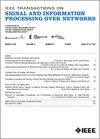Bipartite Graph Approximation by Eigenvalue Optimization
IF 3
3区 计算机科学
Q2 ENGINEERING, ELECTRICAL & ELECTRONIC
IEEE Transactions on Signal and Information Processing over Networks
Pub Date : 2024-03-25
DOI:10.1109/TSIPN.2024.3380351
引用次数: 0
Abstract
Graphs are a powerful tool for representing entities and their relationships. Current advances in graph signal processing have made it possible to analyze graph-based data more effectively. Recent research show that, to ensure critical sampling, manyfilterbank design algorithms are only applicable to bipartite graphs. However, general graph signals may not exist on a bipartite graph structure. To overcome this difficulty, we propose in this paper a novel algorithm to find a bipartite approximation to the original non-bipartite graph while preserving its global structure. To achieve this goal, the original bipartite graph approximation (BGA) problem is constructed based on eigenvalue optimization of adjacency matrix, which is then relaxed so as to obtain a closed-form solution. We introduce the alternating direction method of multipliers (ADMM) to achieve a single bipartite graph or a set of edge-disjoint bipartite subgraphs that approximates the original graph. Additionally, we develop a distributed version of the BGA to address the computational challenges when processing large-scale graphs. Experimental results demonstrate the effectiveness of the proposed method and suggest it as a promising alternative approach for bipartite graph decomposition.通过特征值优化实现双方图逼近
图形是表示实体及其关系的强大工具。目前,图信号处理技术的进步使得更有效地分析基于图的数据成为可能。最近的研究表明,为了确保临界采样,许多滤波器库设计算法只适用于二叉图。然而,一般的图信号可能并不存在于双叉图结构中。为了克服这一困难,我们在本文中提出了一种新颖的算法,即在保留原非二叉图的全局结构的同时,找到原非二叉图的二叉近似图。为了实现这一目标,我们基于邻接矩阵的特征值优化构建了原始双向图近似(BGA)问题,然后对其进行松弛,从而得到闭式解。我们引入了乘法交替方向法(ADMM),以获得近似原始图的单个双方形图或一组边缘相交的双方形子图。此外,我们还开发了分布式版本的 BGA,以应对处理大规模图时的计算挑战。实验结果证明了所提方法的有效性,并建议将其作为一种有前途的双方形图分解替代方法。
本文章由计算机程序翻译,如有差异,请以英文原文为准。
求助全文
约1分钟内获得全文
求助全文
来源期刊

IEEE Transactions on Signal and Information Processing over Networks
Computer Science-Computer Networks and Communications
CiteScore
5.80
自引率
12.50%
发文量
56
期刊介绍:
The IEEE Transactions on Signal and Information Processing over Networks publishes high-quality papers that extend the classical notions of processing of signals defined over vector spaces (e.g. time and space) to processing of signals and information (data) defined over networks, potentially dynamically varying. In signal processing over networks, the topology of the network may define structural relationships in the data, or may constrain processing of the data. Topics include distributed algorithms for filtering, detection, estimation, adaptation and learning, model selection, data fusion, and diffusion or evolution of information over such networks, and applications of distributed signal processing.
 求助内容:
求助内容: 应助结果提醒方式:
应助结果提醒方式:


